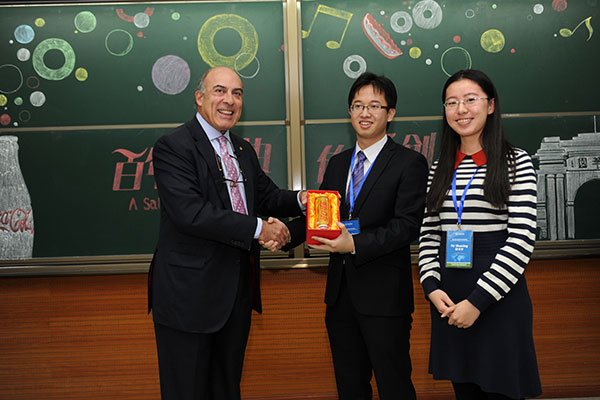 |
|
Muhtar Kent, Chairman and Chief Executive Officer of the Coca-Cola Company exchange gifts with Tsinghua SME students.[Provided to chinadaily.com.cn] |
Muhtar Kent, Chairman and Chief Executive Officer of The Coca-Cola Company, Advisory Board Member of Tsinghua University School of Economics and Management (SEM) comes to Tsinghua SEM to give a lecture on Marketing & Building Successful Brands, unveiling the mystery of the Coca-Cola frenzy throughout the world.
Everything begins with taste
For Coca-Cola, "Everything begins with taste". From 1886 when the first bottle of Coca-Cola was created, the strict demand of taste has been the legacy of The Coca-Cola Company over the past century.
For Kent, good taste is at the heart of why Coca-Cola has grown ever since. "Good, delicious, refreshing" is what makes Coca-Cola so often consumed by people at dinner table. Not only that, Coca-Cola's unique taste lives on in people's unforgettable memory. The connection built between the brand and consumers is no longer limited to the use of the goods, but the sympathy of the consumer to the brand – Coca-Cola has a legacy of being part of good times.
Doorway to marketing
A century-old brand would not be possible without a good foundation. Seeing more emerging enterprises in China, Kent talks about the two key measures when Coca-Cola was first founded: classic packaging and display at point of sale. Packaging is what made Coca-Cola different from those who imitated it – cannot be copied, not to mention replaced. Retailing, on the other hand, helps Coca-Cola knock the door of the market and understand consumers' preferences.
Until five decades ago, "one package, one flavor" has long been the secret of Coca-Cola's dominance over the market. Classic and distinctive traits make product and brand unique, but should not hinder it from moving forward and become monotonous. Today, people have more expectations for life, the same goes for beverages. Kent says that Coca-Cola started very early to polish brand, flavor, price, source and material to meet people's increasingly diversified demands for beverages. The Coca-Cola Company has more than 500 brands and 3500 beverages nowadays. "Coca-Cola is able to cater to any type of consumers, lifestyle and occasion." Kent says in his speech.
Three macro trends reshaping the market
Over the past decades, Coca-Cola has been well-known for the powerful ad notion "collaging the exciting creative initiatives". Today, Coca-Cola's marketing method is reshaped by a series of macro trends in the consuming market. As Kent sees it, these macro trends can be classified as two types: 1. the trend that is changing the expected role of company and brand, for example, ageing, the rise of the young generation, resource scarcity and the shift of economic centers. 2. the trend that is empowering consumers, such as the increased availability of mobility that gives global consumers more voice, the more intense focus on health, life quality and personal needs. These macro trends challenge brand to not only confine to meeting the demands, but the responsibility to the society. This is the challenge. Coca-Cola turns the challenge into the opportunity that makes it stand out and a great brand.
Kent also talks much about urbanization, technology, rapid development of connectivity and the rise of the millennium and their impact on brand marketing.
Two-way interaction and mass personalization prevail
Kent speaks of an effective marketing is not only about consumers impression about the brand, what matters even more is to make consumers express. When expression is being made, the thinking on the brand and on the message it tries to convey is done. Consumers are able to see their own tags on the brand and make further emotional connections. Drawing on the case of Share a Coke, Kent illustrates how Coca-Cola uses two-way interaction and mass personation to make brand sparkling.
Innovation and respect shape the future
At the end of the lecture, Kent shares two key factors of growing brand-consumer relations: innovation and respect.
Kent believes that innovation on the one hand needs to meet consumers' demand for flavor. On the other, helps sustainable development and helps enterprises to better deliver on social responsibility. Coca-Cola's appeal to innovation started with the basic product and then continued to the whole brand. The PlantBottle that's made of plant, can sold together with Coca-Cola that covers over 100 beverages such as soda, water, sports drink and lemonade at Freestyle machines. The efforts made in innovation are to better meet the needs of the consumers, demonstrating Coca-Cola's promise to make innovation.
Consumers' respect and preference on the brand are highly connected. Kent points out that sustainability is not only seen from technological innovation, but also from the coordination among enterprises, the government and citizens – the three develop together through mutual assistance. In this way the connectivity between brand and society can be made so as to create a sustainable brand and business.
In interactive session, Kent answers questions includes brand diversity and creativity. When answering the question of why low calories Coca-Cola aren't popular in China, Kent points out that Coca-Cola Zero and Coca-Cola Light in China has grown exponentially, it is a question of consumer preference. Kent also response to the question of how The Coca-Cola Company remain competitive in marketplace. He tells students that the innovation is always the key to continue the leadership. Freestyle machine and home brewing systems are the trends in 10 years. New and innovative products cause incremental brand preference, and The Coca-Cola Company is working hard towards that goal.
